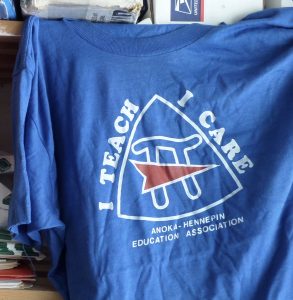#1162 – Dick Bernard: Labor Day, back to school for most of Minnesota's school kids.
From Sunday’s Minneapolis Star Tribune about the recovery of Jacob Wetterlings body more than 25 years after he was kidnapped near St. Joseph MN and killed in October, 1979: here is the local news.
Jacob is at peace, and the lessons of his tragic death live on through the dedication of his family and many others who carry forward the message of his tragic death. Here for more information.
*
Most Minnesota schools begin on Tuesday, September 6.
In rough terms, it appears there will be about 900,000 students enrolled this year, with about 125,000 school staff, of which licensed personnel are about half. Roughly one of five Minnesotans will be in public school tomorrow. Here is a snapshot. Public Education is central to a functioning society.
Public Education has been an important part of my entire personal and professional life, from growing up in a family where my parents were both career public school teachers, to, this year, having eight grandchildren in Minnesota public schools.
Each year for many years one of my mandatory stops at the Minnesota State Fair is the booth of Education Minnesota, formerly called MEA (Minnesota Education Association) and MFT (Minnesota Federation of Teachers). This year was no different. Again this year I got my photo at the “Ed MN” booth (see end of post); Saturday, back again, I stopped in and took a photo of a couple of Minnesota Kindergarten teachers.
(click to enlarge)
I have great admiration for Minnesota Public Schools and the staff who are their face every day. Being a human institution, they are not perfect, but their charge is to serve children from early childhood through 12th grade. They do it very well.
My experience as a school teacher began in 1963; this year I choose to remember 1969, the year my oldest son began Kindergarten at age 5 in the explosively growing Anoka-Hennepin School District.
Tom attended Franklin Elementary School in Anoka. His teacher that year was Miss Murphy, an older lady who was very kindly and a magician with kids. She retired a year or two later.
Kindergarten at that point in time was half day, as I recall. (Full day kindergarten was years away; kindergarten itself did not exist in my own growing up years.)
In 1969, I recall that Tom’s kindergarten class included 36 youngsters. If you can imagine it, Miss Murphy had no classroom assistance. Her way of coping with this was to work with half of the students at a time, and in some magical way keep the other half occupied more or less by themselves in the same room, all by herself.
That is how I remember it.
Anoka-Hennepin was then an extremely rapidly growing school district, with a very low tax base. I can’t find fault with what today would be considered intolerable conditions. Young families moved in, and the district just couldn’t keep up with the growth.
Fast forward to today, and conditions are better.
And it is now recognized that the earlier a child is exposed to all aspects of education, including socialization, the better off he or she will be in the years that follow.
Money spent on children is money invested, not spent.
I wish all Kindergarten teachers, indeed all teachers, and all of their students, a good year. And I also wish that the certain unforseen events are minimal.
Happy New (School) Year!
POSTNOTE:
Sunday afternoon I flipped on the local PBS station, and happened across a sequence of three programs on early U.S. Labor Movement history: Minnesota’s Iron Range; Upper Michigan’s Copper Country; and West Virginia’s Coal Country. It was a gripping two to three hours, with characters like Mother Jones, and John L. Lewis. The programs may be repeated and are well worth watching.
Succinctly, management was terrified of organized labor.
In my opinion, in many ways it still is terrified, to everyone’s detriment, including management itself. (Organized Labor built this country’s middle class, which, in turn, built this country’s economy, both as producers and consumers. It is the most elementary economics.)
The programs caused me to revisit my stop at that Education Minnesota booth on Saturday: Education Minnesota is, I think, Minnesota’s largest single AFL-CIO Union.
A couple of weeks ago I had occasion to revisit my own part in the labor movement, going back to the late 1960s and early 1970s, now near 50 years ago. The short essay was not written for this blog, but nonetheless fits. Here it is, if you’re interested: UniServ, one persons experience, Dick Bernard Aug 19, 2016.
It is easy to criticize unions. As for me, I’m very proud to have been part of the organized labor movement. When Unions die, our society will die along with them.




Leave a Reply
Want to join the discussion?Feel free to contribute!